Effect of Land-Use Change on the Urban Heat Island in the Fukuoka–Kitakyushu Metropolitan Area, Japan
Abstract
:1. Introduction
2. Materials and Methods
2.1. Outline of the Meso-Scale Meteorological Model
2.2. Outline of the National Land Numerical Information Land-Use Datasets
2.3. Analysis Conditions
2.4. Outline of the Doppler LiDAR System
3. Results and Discussion
3.1. Comparing Observation and Simulation Results of the Surface Air Temperature
3.2. Surface Air Temperature Change Caused by Land-Use Change
3.3. Transition of the Sea Breeze over the Urban Area
4. Conclusions
Acknowledgments
Author Contributions
Conflicts of Interest
References
- Japan Meteorological Agency. Heat Island Monitoring Report 2014. Available online: http://www.data.jma.go.jp/cpdinfo/himr/2014/index.html (accessed on 15 January 2017). (In Japanese)
- Skamarock, W.C.; Klemp, J.B.; Dudhia, J.; Gill, D.O.; Barker, D.M.; Duda, M.G.; Huang, X.Y.; Wang, W.; Powers, J.G. A Description of the Advanced Research WRF Version 3. NCAR Tech. Note 2008, 468, 88. [Google Scholar]
- Holt, T.; Pullen, J. Urban canopy modeling of the New York City metropolitan area: A comparison and validation of single-and multilayer parameterizations. Mon. Weather Rev. 2007, 135, 1906–1930. [Google Scholar] [CrossRef]
- Miao, S.; Chen, F.; LeMone, M.A.; Tewari, M.; Li, Q.; Wang, Y. An Observational and Modeling Study of Characteristics of Urban Heat Island and Boundary Layer Structures in Beijing. J. Appl. Meteorol. Climatol. 2009, 48, 484–501. [Google Scholar] [CrossRef]
- Giannaros, T.M.; Melas, D.; Daglis, I.A.; Keramitsouglou, I.; Kourtidis, K. Numerical study of the urban heat island over Athens (Greece) with the WRF model. Atmos. Environ. 2013, 73, 103–111. [Google Scholar] [CrossRef]
- Kusaka, H.; Hara, M.; Takane, Y. Urban Climate Projection by the WRF Model at 3-km Horizontal Grid Increment: Dynamical Downscaling and Predicting Heat Stress in the 2070’s August for Tokyo, Osaka, and Nagoya Metropolises. J. Meteorol. Soc. Jpn. 2012, 90B, 47–63. [Google Scholar] [CrossRef]
- Hisada, Y.; Uechi, T.; Matsunaga, N. A relationship between the characteristics of sea breeze and land-use in Fukuoka Metropolitan area. In Proceedings of the 7th International Conference on Urban Climate, Yokohama, Japan, 2 July 2009. [Google Scholar]
- National Land Information Division, National Spatial Planning and Regional Policy Bureau, MLIT of Japan. National Land Numerical Information Download Service. Available online: http://nlftp.mlit.go.jp/ksj-e/index.html (accessed on 15 January 2016).
- Lane, S.E.; Barlow, J.F.; Wood, C.R. An assessment of a three-beam Doppler lidar wind profiling method for use in urban areas. J. Wind Eng. Ind. Aerodyn. 2013, 119, 53–59. [Google Scholar] [CrossRef]
- Drew, D.R.; Barlow, J.F.; Lane, S.E. Observations of wind speed profiles over Greater London, UK, using a Doppler lidar. J. Wind Eng. Ind. Aerodyn. 2013, 121, 98–105. [Google Scholar] [CrossRef]
- Yoshikado, H.; Kondo, H. Inland penetration of the sea breeze over the suburban area of Tokyo. Boudary Layer Meteorol. 1989, 48, 389–407. [Google Scholar] [CrossRef]
- Kawamoto, Y. Doppler lidar observations of wind fields over the Tokyo metropolitan area. In Proceedings of the 8th International Conference on Urban Climate, Dublin, Ireland, 6–10 August 2012. [Google Scholar]
- Yoshikado, H.; Nakajima, K.; Kawamoto, Y.; Ooka, R. Heat Budget of Sea Breezes Passing through Urbanized Areas of Tokyo. Tenki 2014, 61, 541–548. (In Japanese) [Google Scholar]
- Hisada, Y.; Oda, Y.; Matsunaga, N. A simulation of sea breeze over Fukuoka Metropolitan are. Proc. Hydraul. Eng. 2008, 52, 235–240. (In Japanese) [Google Scholar] [CrossRef]
- Kawamoto, Y. Effect of urbanization on the urban climate in coastal city, Fukuoka-Kitakyushu metropolitan area, Japan. In Proceedings of the 9th International Conference on Urban Climate, Toulouse, France, 20–24 July 2015. [Google Scholar]
- Li, D.; Bou-Zeid, E.; Barlage, M.; Chen, F.; Smith, J.A. Development and evaluation of a mosaic approach in the WRF-Noah framework. J. Geophys. Res. Atmos. 2013, 118, 11918–11935. [Google Scholar] [CrossRef]
- Thompson, G.; Field, P.R.; Rasmussen, R.M.; Hall, W.D. Explicit Forecasts of Winter Precipitation Using an Improved Bulk Microphysics Scheme. Part II: Implementation of a New Snow Parameterization. Mon. Weather Rev. 2008, 136, 5095–5115. [Google Scholar] [CrossRef]
- Mlawer, E.J.; Taubman, S.J.; Brown, P.D.; Iacono, M.J.; Clough, S.A. Radiative transfer for inhomogeneous atmosphere: RRTM, a validated correlated-k model for the longwave. J. Geophys. Res. 1997, 102, 16663–16682. [Google Scholar] [CrossRef]
- Chou, M.D.; Suarez, M.J.; Liang, X.Z.; Yan, M.M.H. A thermal infrared radiation parameterization for atmospheric studies. NASA Tech. Memo. 2001, 19, 68. [Google Scholar]
- Janjic, Z.I. Nonsingular Implementation of the Mellor–Yamada Level 2.5 Scheme in the NCEP Meso model. NCEP Off. Note 2002, 437, 61. [Google Scholar]
- Tewari, M.; Chen, F.; Wang, W.; Dudhia, J.; LeMone, M.A.; Mitchell, K.; Ek, M.; Gayno, G.; Wegiel, J.; Cuenca, R.H. Implementation and verification of the unified NOAH land surface model in the WRF model. In Proceedings of the 20th Conference on Weather Analysis and Forecasting/16th Conference on Numerical Weather Prediction, Seattle, DC, USA, 22–26 January 2004. [Google Scholar]
- Grell, G.A.; Devenyi, D. A generalized approach to parameterizing convection combining ensemble and data assimilation techniques. Geophys. Res. Lett. 2002, 29, 38-1–38-4. [Google Scholar] [CrossRef]
- Yoshikado, H. Numerical Study of the Daytime Urban Effect and Its Interaction with the Seat Breeze. J. Appl. Meteorol. 1992, 31, 1146–1164. [Google Scholar] [CrossRef]
- Yoshikado, H. Interaction of the Sea Breeze with Urban Heat Islands of Different Sizes and Locations. J. Meteorol. Soc. Jpn. 1994, 72, 139–143. [Google Scholar] [CrossRef]
- Kusaka, H.; Kimura, F.; Hirakuchi, H.; Mizutori, M. The Effects of Land-Use Alteration on the Sea Breeze and Daytime Heat Island in the Tokyo Metropolitan Area. J. Meteorol. Soc. Jpn. 2000, 78, 405–420. [Google Scholar] [CrossRef]
- Kawamoto, Y.; Yoshikado, H.; Ooka, R.; Hayami, H.; Huang, H.; Khiem, M.V. Sea Breeze Blowing into Urban Areas: Mitigation of the Urban Heat Island Phenomenon. In Ventilating Cities: Air-Flow Criteria for Healthy and Comfortable Urban Living; Kato, S., Hiyama, K., Eds.; Springer: Dordrecht, The Netherland, 2012; pp. 11–32. ISBN 978-94-007-2770-0. [Google Scholar]
- Anthes, R.A.; Warner, T.T. Development of hydrodynamic models suitable for air pollution and other mesometeorological studies. Mon. Weather Rev. 1978, 106, 1045–1078. [Google Scholar] [CrossRef]
- Lorenz, E.N. Deterministic Nonperiodic Flow. J. Atmos. Sci. 1963, 20, 130–141. [Google Scholar] [CrossRef]
- Lorenz, E.N. The predictability of a flow which possesses many scales of motion. Tellus 1969, 21, 289–307. [Google Scholar] [CrossRef]


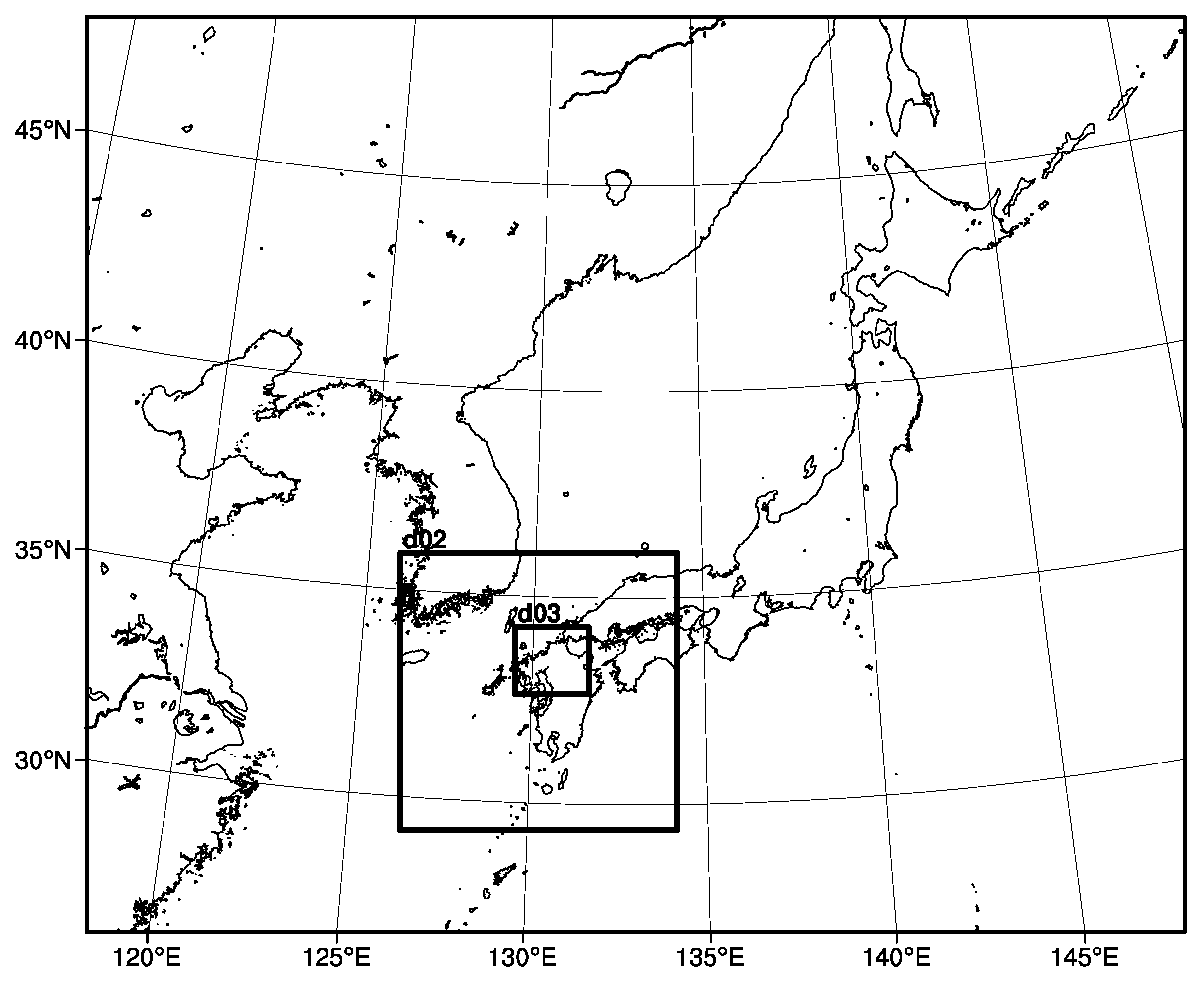


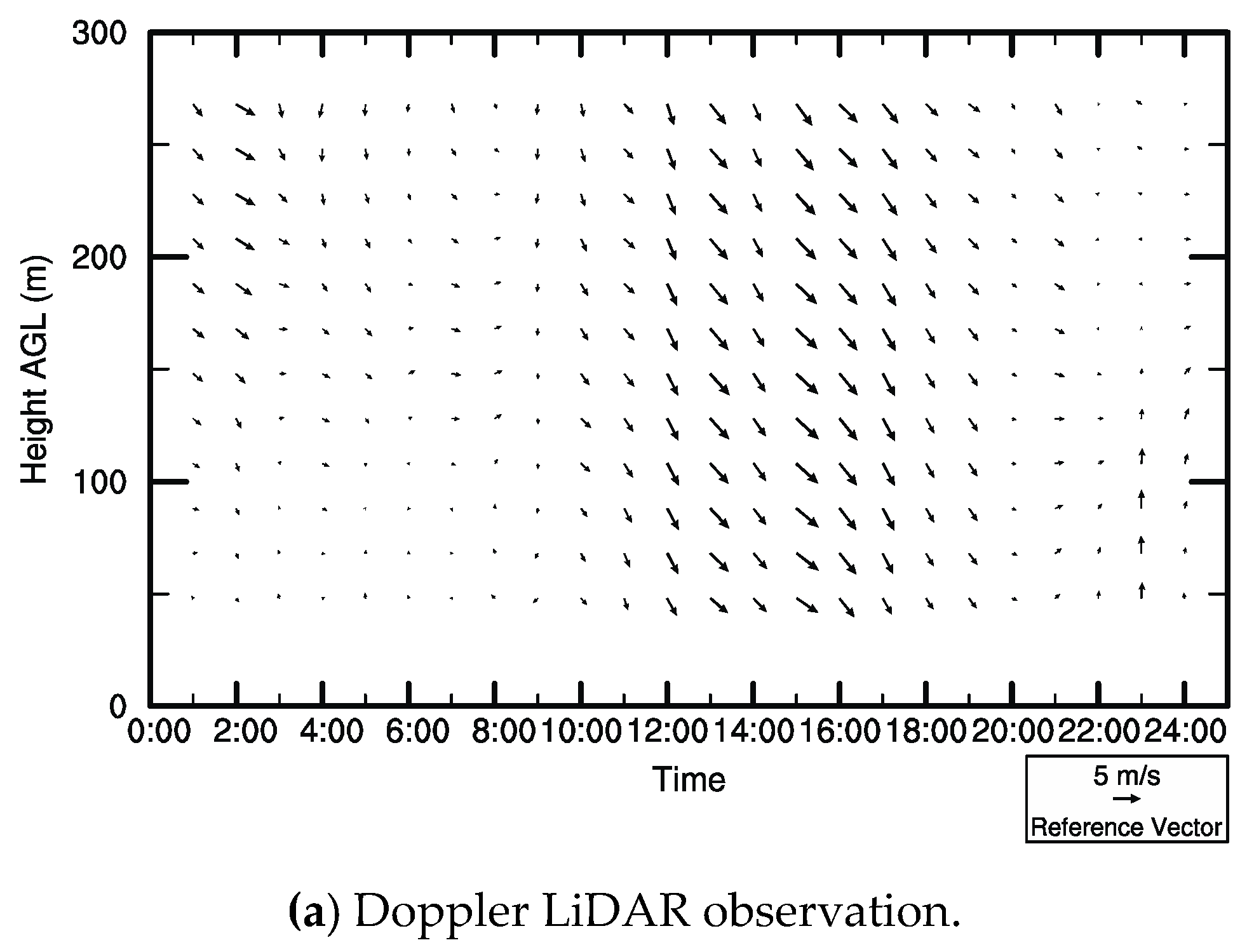
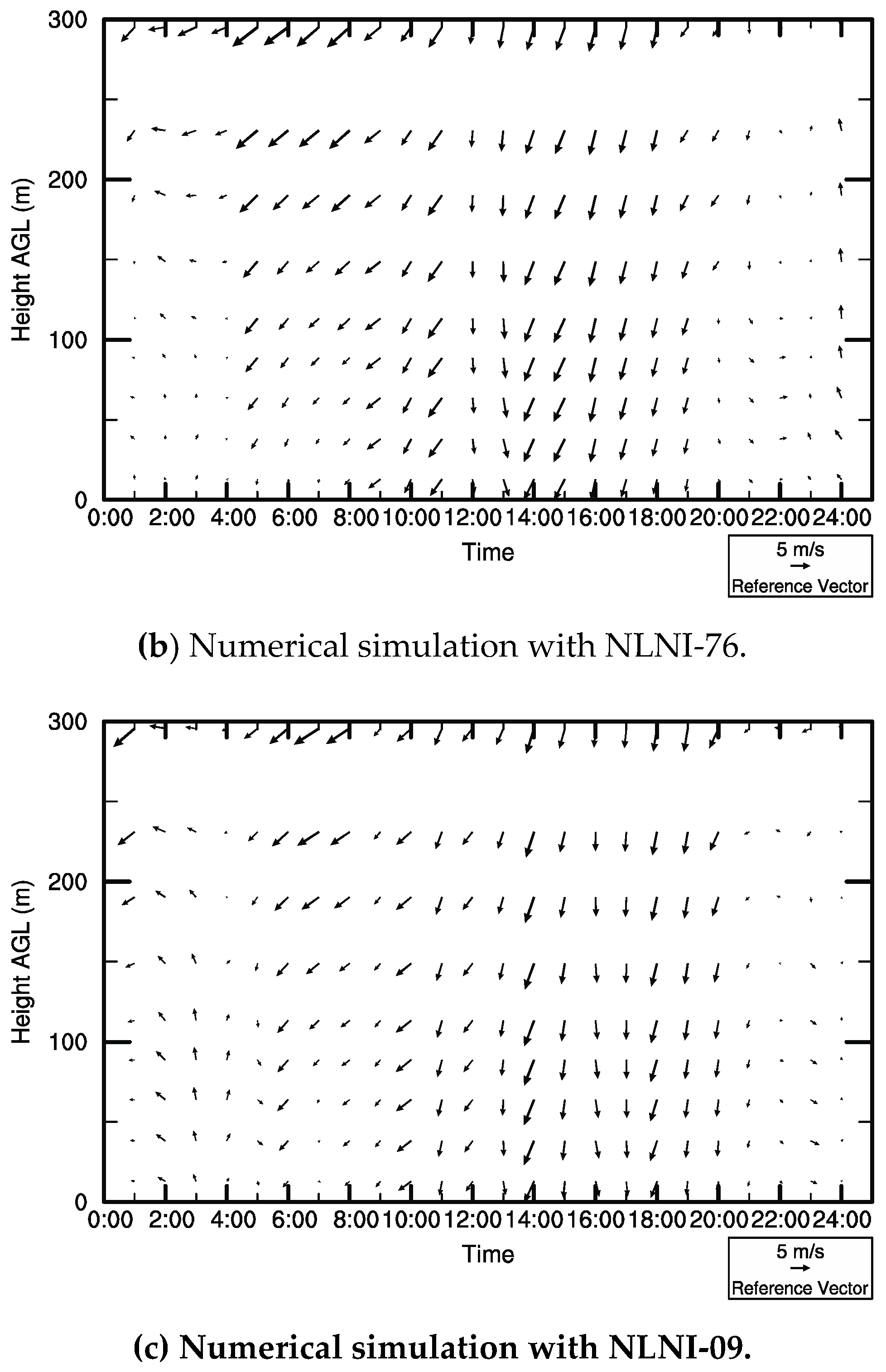
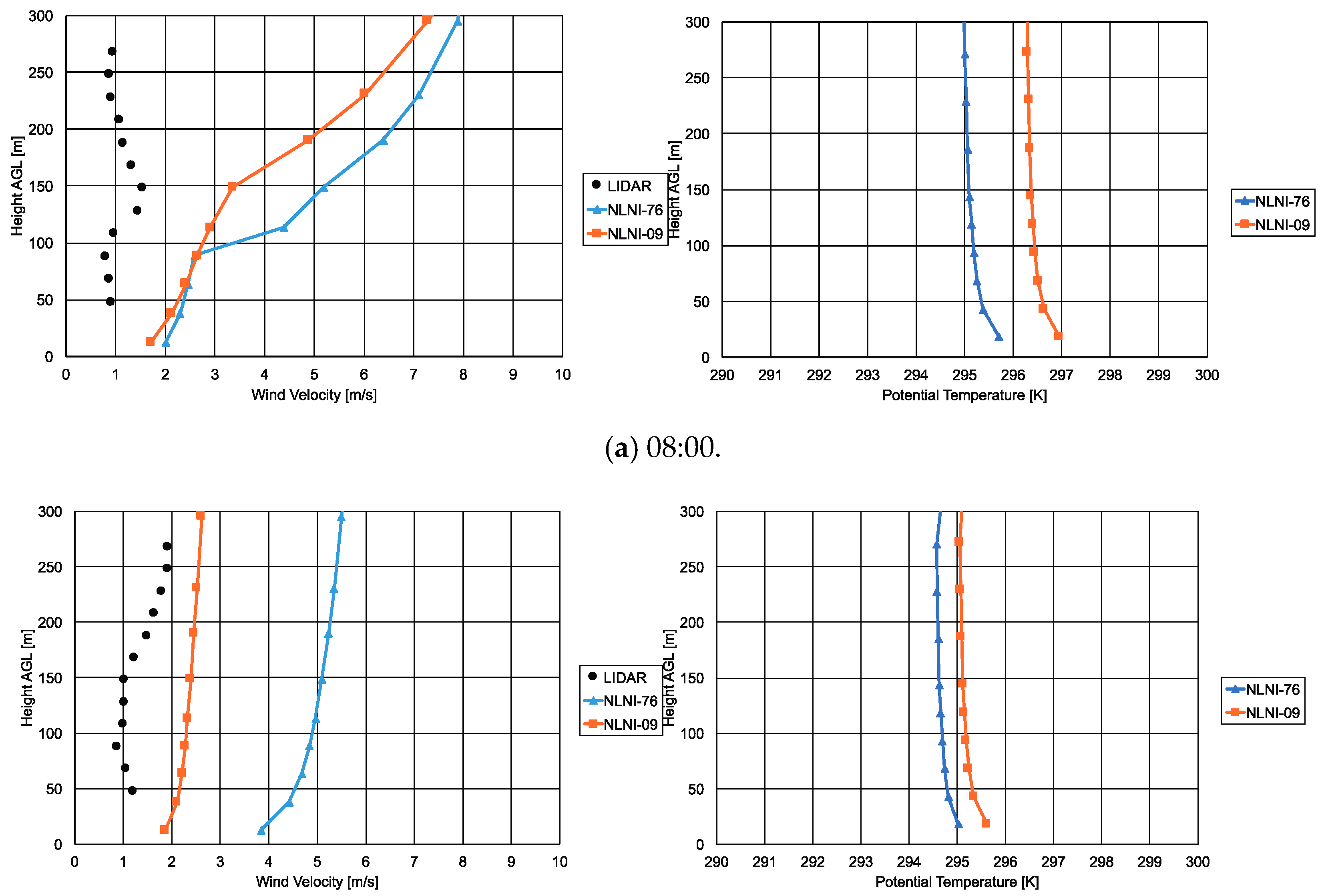
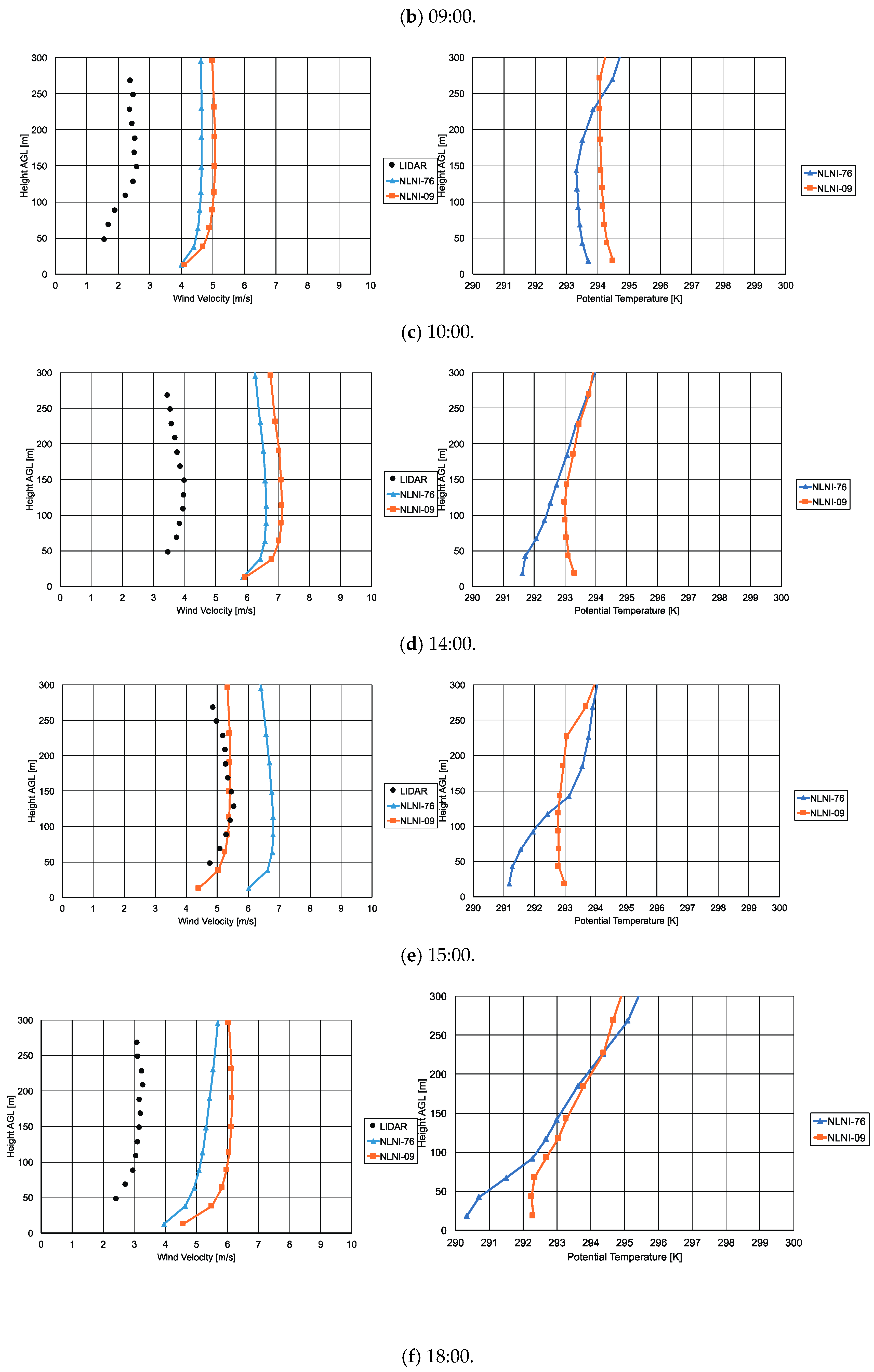
| Land-Use Categories in WRF (Provided by the U.S. Geological Survey) | Land-Use Categories in NLNI in 1976 | Land-Use Categories in NLNI in 2009 |
|---|---|---|
| Irrigated Cropland and Pasture | Paddy field | Paddy field |
| Mixed Dryland/Irrigated Cropland and Pasture | Field | Other agricultural land |
| Orchard | ||
| Other tree plantation | ||
| Mixed Forest | Forest | Forest |
| Barren or Sparsely Vegetated | Wasteland | Wasteland |
| Other land | Other land | |
| Golf course | ||
| Urban and Built-Up Land | Land for building | Land for building |
| Trunk transportation land | Trunk transportation land (Road) | |
| Trunk transportation land (Rail) | ||
| Water Bodies | Lake | River basin, lake, and marsh |
| River | ||
| Beach | Beach | |
| Seawater body | Seawater body |
| Site | NLNI-09 | USGS | ||
|---|---|---|---|---|
| ME (°C) | RMSE (°C) | ME (°C) | RMSE (°C) | |
| 1. Munakata | −0.741 | 2.553 | −1.722 | 3.170 |
| 2. Yahata | 0.633 | 3.150 | −1.038 | 3.324 |
| 3. Kuko-kitamachi | 0.093 | 3.036 | −0.044 | 2.979 |
| 4. Yukuhashi | −0.492 | 3.160 | −1.608 | 3.590 |
| 5. Iizuka | −0.172 | 3.164 | −1.628 | 3.748 |
| 6. Maebaru | 0.052 | 3.191 | −0.998 | 3.296 |
| 7. Fukuoka | 1.430 | 3.397 | 0.674 | 3.081 |
| 8. Hakata | 1.032 | 3.317 | −1.066 | 3.652 |
| 9. Dazaifu | 0.290 | 3.184 | −0.996 | 3.377 |
| 10. Soeda | −1.238 | 3.435 | −0.153 | 3.006 |
| 11. Asakura | −0.208 | 3.473 | −1.193 | 3.708 |
| 12. Kurume | 0.845 | 3.427 | −0.626 | 3.548 |
| 13. Kurogi | −0.665 | 3.435 | −0.904 | 3.466 |
| 14. Omuta | 0.924 | 3.407 | 1.060 | 3.408 |
| Total | 0.128 | 3.247 | −0.731 | 3.391 |
| Land-Use Fraction in NLNI-09 | Dominant Land-Use Category in USGS | ||||||
|---|---|---|---|---|---|---|---|
| Urban and Built-Up Land | Irrigated Cropland and Pasture | Mixed Dryland/Irrigated Cropland and Pasture | Mixed Forest | Barren or Sparsely Vegetated | Water Bodies | ||
| 1. Munakata | 26.7% | 41.9% | 4.2% | 18.8% | 1.7% | 6.7% | Shrubland |
| 2. Yahata | 67.2% | 0.0% | 0.0% | 12.4% | 20.4% | 0.0% | Cropland/Grassland Mosaic |
| 3. Kuko-kitamachi | 0.1% | 0.0% | 0.0% | 0.0% | 21.3% | 78.5% | Water Bodies |
| 4. Yukuhashi | 50.7% | 39.8% | 1.0% | 0.3% | 3.3% | 4.9% | Cropland/Grassland Mosaic |
| 5. Iizuka | 53.7% | 7.0% | 0.0% | 17.1% | 8.8% | 13.5% | Shrubland |
| 6. Maebaru | 45.0% | 44.5% | 2.0% | 0.0% | 2.5% | 6.0% | Dryland Cropland and Pasture |
| 7. Fukuoka | 74.6% | 0.0% | 0.0% | 8.7% | 8.3% | 8.4% | Urban and Built-up Land |
| 8. Hakata | 46.2% | 0.0% | 0.0% | 6.8% | 45.9% | 1.1% | Shrubland |
| 9. Dazaifu | 57.1% | 5.4% | 9.4% | 18.7% | 8.1% | 1.3% | Shrubland |
| 10. Soeda | 10.4% | 13.8% | 5.2% | 62.3% | 4.8% | 3.5% | Urban and Built-up Land |
| 11. Asakura | 28.6% | 62.1% | 7.2% | 1.7% | 0.4% | 0.0% | Irrigated Cropland and Pasture |
| 12. Kurume | 44.5% | 44.0% | 0.9% | 0.0% | 7.4% | 3.2% | Irrigated Cropland and Pasture |
| 13. Kurogi | 3.3% | 34.2% | 48.0% | 13.0% | 0.0% | 1.5% | Cropland/Woodland Mosaic |
| 14. Omuta | 60.3% | 11.2% | 8.2% | 16.3% | 3.5% | 0.5% | Urban and Built-up Land |
© 2017 by the author. Licensee MDPI, Basel, Switzerland. This article is an open access article distributed under the terms and conditions of the Creative Commons Attribution (CC BY) license (http://creativecommons.org/licenses/by/4.0/).
Share and Cite
Kawamoto, Y. Effect of Land-Use Change on the Urban Heat Island in the Fukuoka–Kitakyushu Metropolitan Area, Japan. Sustainability 2017, 9, 1521. https://doi.org/10.3390/su9091521
Kawamoto Y. Effect of Land-Use Change on the Urban Heat Island in the Fukuoka–Kitakyushu Metropolitan Area, Japan. Sustainability. 2017; 9(9):1521. https://doi.org/10.3390/su9091521
Chicago/Turabian StyleKawamoto, Yoichi. 2017. "Effect of Land-Use Change on the Urban Heat Island in the Fukuoka–Kitakyushu Metropolitan Area, Japan" Sustainability 9, no. 9: 1521. https://doi.org/10.3390/su9091521





